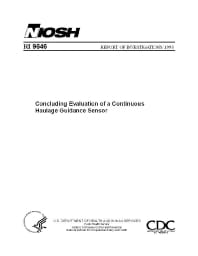Mining Publication: Concluding Evaluation of a Continuous Haulage Guidance Sensor
Original creation date: October 1998
Authors: JJ Sammarco
NIOSHTIC2 Number: 20000282
Pittsburgh, PA: U.S. Department of Health and Human Services, Public Health Service, Centers for Disease Control and Prevention, NIOSH, DHHS (NIOSH) Publication No. 98-161, Report of Investigations 9646, 1998 Oct; :1-17
The mining industry has the highest average annual fatality rate among major U.S. industries. To address this, the National Institute for Occupational Safety and Health, Pittsburgh Research Laboratory (PRL), is conducting major research programs to reduce the hazard exposure of miners. One of the recently concluded programs at PRL developed the enabling technology for remote-controlled mining. An application involves the manual process of extracting and hauling coal where operators, in tight confines of a mine, can be struck or caught by mobile machinery. The approach to remedy this problem uses a guidance system on the continuous haulage equipment so that it follows the continuous mining machine that extracts coal. This, in essence, involves sensor-based docking of the machines. Sensors functioning in the hostile mine environment of dust, methane gas, and water play the key role. Computer analysis of the mining machine's movements and empirical machine characterizations established operating requirements and spatial limitations to ensure proper loading of coal into the haulage equipment. These data served in the selection of a guidance sensor. Technologies such as scanning laser systems and ultrasonic sensors have frequently been used in other applications, but were found unacceptable. However, a near-infrared sensor employing active targets met the requirements. The sensor has a nominal 75 degree conical field of view and a range from 0.1 to 18.0 m. For the single-target mode, nominal range accuracy was 4.3% at a distance of 3.65 m. Correction algorithms were generated, which reduced the error to 0.6%. Airborne dust testing showed less than an additional Using four targets, the nominal range accuracy was 0.4% without correction algorithms. Analysis of dynamic testing of continuous miner and haulage showed that accuracy was maintained and total target loss did not occur. A guidance system for the haulage system to follow the mining machine does not exist commercially. Such a system for the haulage system to follow the mining machine does not exist commercially. Such a system can reduce fatalities, injuries, and exposure to dust and noise.

NIOSHTIC2 Number: 20000282
Pittsburgh, PA: U.S. Department of Health and Human Services, Public Health Service, Centers for Disease Control and Prevention, NIOSH, DHHS (NIOSH) Publication No. 98-161, Report of Investigations 9646, 1998 Oct; :1-17
- Development and Application of Reservoir Models and Artificial Neural Networks for Optimizing Ventilation Air Requirements in Development Mining of Coal Seams
- Particulate Penetration of Porous Foam Used as a Low Flow Rate Respirable Dust Size Classifier
- Passive Fiber Optic System for Locating, Tracking, and Communicating with Personnel in Coal Mines
- Progress Toward a Reduced Exposure Mining System
- Refuge Alternatives in Underground Coal Mines
- Remote Methane Sensors
- Safe and Economical Inerting of Sealed Mine Areas
- Technical Solutions for Enhancements to Mine Safety Using Barricade II Fire Blocking Gel
- Ultra-Low Frequency Through-the-Earth Communication Technology
- Wireless Mesh Mine Communication System